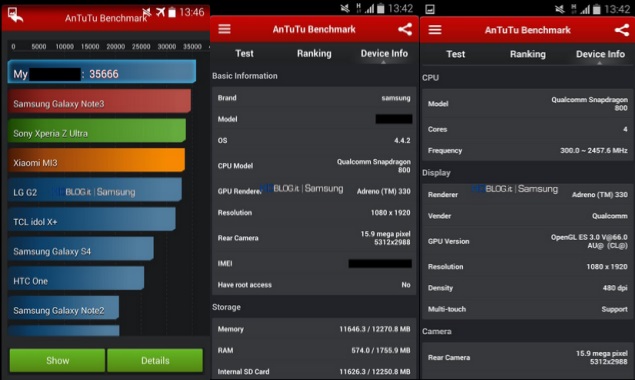
Samsung's much-anticipated Galaxy S5 has been reportedly spotted on AnTuTu benchmark listings, along with details of the innards of the device.
An Italian publication has posted the AnTuTu benchmark screenshots of the yet-to-be-announced Samsung Galaxy S5. However, the site clearly reveals that the benchmarks have been tested on a prototype or a beta version of the device and not a final product. As per the site, the alleged prototype of the Galaxy S5 has been sent to major mobile carriers for testing purposes.
According to the site, the Galaxy S5 will sport a 16-megapixel rear camera and will be powered by a 2.5GHz quad-core Snapdragon 800 processor. Further, the leaked benchmark screenshots reveal a full-HD display in tow offering a pixel density of 480ppi.
Notably, the device being said to be the prototype of the Galaxy S5 is seen running Android 4.4.2 KitKat version. The leaked screenshots also show the alleged prototype of the Galaxy S5 scoring a remarkable 35,666, and is seen leading smartphones like Samsung Galaxy Note 3, Sony Xperia Z Ultra, LG G2, Samsung Galaxy S4 and HTC One.
Samsung has already sent media invites for its "UnPacked 5" event, where the company is said to unveil the next Galaxy flagship smartphone at the sidelines of MWC 2014 on February 24 in Barcelona.
On Thursday, a report citing an insider with knowledge of Samsung's plans suggested that the Galaxy S5 unveiling will be a low-key event. According to the report, Samsung Galaxy S4's underperformance in terms of sales, despite of a flashy launch in New York last year has been a reason for the company to go for a toned-down event.
In addition, the report also noted that Samsung could showcase the Galaxy Gear successor along with Galaxy S5 at MWC, something we've heard previously, from a Samsung VP.
The Galaxy S5 is widely expected to feature the fingerprint scanner, which is said to be integrated into the device's display panel.

No comments:
Post a Comment